| UNITED STATES |
| SECURITIES AND EXCHANGE COMMISSION |
| Washington, D.C. 20549 |
FORM N-CSR |
CERTIFIED SHAREHOLDER REPORT OF REGISTERED |
MANAGEMENT INVESTMENT COMPANIES |
| Investment Company Act File Number: 811-7059 |
| T. Rowe Price Blue Chip Growth Fund, Inc. |
| (Exact name of registrant as specified in charter) |
| 100 East Pratt Street, Baltimore, MD 21202 |
| (Address of principal executive offices) |
| David Oestreicher |
| 100 East Pratt Street, Baltimore, MD 21202 |
| (Name and address of agent for service) |
| Registrant’s telephone number, including area code: (410) 345-2000 |
| Date of fiscal year end: December 31 |
| Date of reporting period: December 31, 2009 |
Item 1: Report to Shareholders
 |
| Blue Chip Growth Fund | December 31, 2009 |
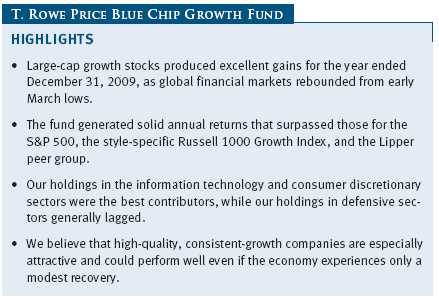
The views and opinions in this report were current as of December 31, 2009. They are not guarantees of performance or investment results and should not be taken as investment advice. Investment decisions reflect a variety of factors, and the managers reserve the right to change their views about individual stocks, sectors, and the markets at any time. As a result, the views expressed should not be relied upon as a forecast of the fund’s future investment intent. The report is certified under the Sarbanes-Oxley Act, which requires mutual funds and other public companies to affirm that, to the best of their knowledge, the information in their financial reports is fairly and accurately stated in all material respects.
REPORTS ON THE WEB
Sign up for our E-mail Program, and you can begin to receive updated fund reports and prospectuses online rather than through the mail. Log in to your account at troweprice.com for more information.
Manager’s Letter
Fellow Shareholders
Global stock markets have experienced a broad and powerful recovery. While high unemployment, large budget deficits, and increased regulation of certain industries pose ongoing challenges, economic data suggest the economy is improving. The banking system has been recapitalized, and liquidity in financial and credit markets is being restored. Housing markets, retail sales, and manufacturing have also shown some modest signs of improvement. We anticipate that concerns about inflation could prompt the Fed to change its stance and begin to increase interest rates during 2010. However, we think that inflation and interest rates will rise only moderately. Although the market environment remains quite fragile, the economy and financial markets are healing.
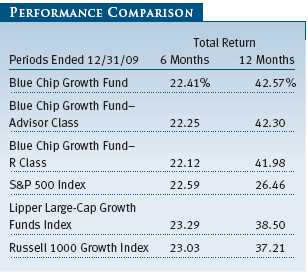
Your fund performed well in 2009, posting one of the strongest performances we have experienced since the fund’s inception more than 16 years ago. We are especially appreciative of your continued confidence in these turbulent times. In our previous letters, we emphasized our view that it is important for shareholders to follow their investment plan and regimen regardless of short-term market fluctuations. While the market has staged a major recovery, historical data suggest that stocks should continue to appreciate over time. We believe that relatively low interest rates, attractive valuations, and continued earnings growth are supportive of favorable investment performance, particularly for large-cap growth stocks.
The Blue Chip Growth Fund produced strong results during its fiscal year ended December 31, 2009, significantly outperforming its benchmarks for the year, as shown in the Performance Comparison table. Many of the portfolio’s largest holdings rallied strongly this year, after declining sharply in 2008. (Results for the Advisor and R Class shares were slightly lower, reflecting their higher fee structures.)
As shown in the Growth of $10,000 chart on page 14, the fund also outpaced the S&P 500 and its Lipper benchmark over the past 10 years. Lipper ranked the fund in the top 11% of its large-cap growth funds universe for the 10-year period ended December 31, 2009. (Based on cumulative total return, Lipper ranked the Blue Chip Growth Fund 134 out of 810, 209 out of 579, and 34 out of 310 funds in the large-cap growth funds universe for the 1-, 5-, and 10-year periods ended December 31, 2009, respectively. Past performance cannot guarantee future results.)
MARKET ENVIRONMENT
In previous letters, we outlined many of the challenges and uncertainties facing financial markets and investors. We have remained constructive on large-cap growth stocks largely based upon compelling valuation, moderate interest rates, and earnings for selected companies that we believed would exceed pessimistic estimates. This positive view has been rewarded in the last few quarters. Unfortunately, many of the challenges remain quite daunting, and stock valuations now reflect investors’ views that substantial improvement is ahead. We concur that improvement is under way, but we recognize the immensity of the challenges that remain.
The massive recapitalization of the global banking system—and the repayment of Troubled Asset Relief Program (TARP) money by selected banks—is an important step forward. Fiscal and monetary stimulus also have contributed to improvements in investor and consumer confidence, housing turnover, retail sales, and some areas of manufacturing. However, the unemployment rate exceeds 10% and could remain elevated for many months. The significant reform plans that Congress and President Obama are pursuing—in health care, for example, along with the huge level of stimulus spending already undertaken—are contributing to large current and projected budget deficits. Periodic weakness in the U.S. dollar has begun to stoke inflation fears and has probably contributed to the sharp rise in oil and other commodity prices. Interest rates have risen moderately, which will make servicing public and private sector debt more expensive and could impair an economic recovery. Government authorities are in a difficult situation and will need to spend (as wisely and carefully as possible) in certain areas, while avoiding large tax increases that could cripple growth.
In short, even the most seasoned investors find the environment unsettling and challenging. However, we recognize that some uncertainty and risk can set the stage for additional stock market gains over time. Ultimately, corporate earnings, inflation (as well as interest rates), and valuation will continue to be key determinants of stock performance. We believe that corporate earnings could continue to be solid at selected companies. Inflation and interest rates could remain relatively low if government authorities show appropriate restraint in fiscal matters. Given the sharp recovery in many stocks, valuations are not nearly as attractive as they were in early March. However, there are many companies that are attractively valued given their growth prospects.
PORTFOLIO REVIEW
Performance in the past six months was driven by a sharp recovery in the stocks in several sectors, including information technology, consumer discretionary, health care, financials, and energy, which struggled in 2008 and early 2009. As investors became more comfortable that the global economy was recovering and that some regulatory changes might not be as onerous as feared, our holdings in various industries recovered.
The information technology sector was the portfolio’s largest contributor in the second half of 2009, led by Apple. The company’s iPhone and iMac personal computers continued to sell quite well despite the challenging economic environment. The company has just released several new products, including iPhones at lower price points, and the iPad, an innovative electronic tablet. Google also staged a steady recovery throughout the period, aided by quarterly results that demonstrated that the company’s core search business is strong despite the moderate success of Microsoft’s competing Bing search offering. Google is benefiting from a recovery in advertising. It is also executing well in mobile and video—its new Android and Nexus phones appear to be well received, and efforts to generate profitability from YouTube videos are starting to gain traction. Our semiconductor stocks also performed well as the year progressed, especially Marvell Technology, Xilinx, and Broadcom. Each company generates strong gross margins and profitability from the specialized components they provide for devices including smartphones, networking gear, and military and industrial applications. (Please refer to the fund’s portfolio of investments for a complete listing of holdings and the amount each represents in the portfolio.)
We also have a large position in Microsoft, which generated good gains. The company has improved its expense management and is benefiting from the launch of several major products, including Windows 7; Bing for Internet search; and Natal, a novel motion-sensing technology for the Xbox game platform. Tencent Holdings, a leading Chinese provider of instant messaging services and online gaming to hundreds of millions of consumers, continued to generate excellent stock performance thanks to robust sales and earnings growth. MasterCard and Visa were also major contributors. These charge-card processing companies are benefiting from the growing global use of credit and debit cards. Both companies are well managed and have shown strong margin improvement as growing revenues create economies of scale and efficiency gains.
Consumer discretionary stocks benefited from the improving economic outlook. Amazon.com was the second-best contributor in the second half and for the year. Its recent quarterly results exceeded estimates by a considerable margin—it was one of the best earnings reports that we have seen from a large company in this challenging environment. Amazon is taking substantial market share within the rapidly growing Internet retailing category in part due to its free shipping program for frequent customers, large third-party sales effort, and excellent customer service. Its Kindle electronic book reader and online book offerings are selling briskly, creating an entirely new growth platform. Priceline.com and Expedia, the leading online travel companies, continue to prosper despite a decline in overall consumer travel. Both have low-cost models (particularly Priceline thanks to its low-bid model) that resonate with consumers seeking to stretch their travel dollars. Several of our traditional retailers, such as Kohl’s and Bed Bath & Beyond, performed relatively well in the downturn and continued to take market share as consumer spending recovered. Media companies, including Discovery Communications, Time Warner, and Walt Disney, also did well as consumer confidence and advertising improved. An increase in discretionary purchasing activity and travel also benefited Starbucks and Marriott.
Our health care sector holdings posted good results, which was a pleasant surprise as more economically sensitive stocks generally led this year’s advance. Express Scripts and Medco are dominant pharmaceutical benefit managers that we think will continue to thrive as generic drug substitution and the increased use of mail order for drug purchasing support strong growth. Express Scripts recently purchased the drug benefit manager NextRx from WellPoint, a leading HMO. We believe the transaction should benefit earnings over time. McKesson, a leading drug distributor and health care information technology solutions provider, is also viewed as part of the cost-control solution and may not be overly affected by regulatory reform. Another top performer was Allergan, a provider of products used in eye care and aesthetic and cosmetic procedures that have low reimbursement risk. We also generated good gains form our position in Intuitive Surgical, the leading provider of robotic surgical systems and supplies used for prostate and hysterectomy surgeries and other surgical procedures. The company has outstanding profitability and generates a substantial amount of revenue from procedures after it has sold the robotics system. The company’s earnings, cash flow, and stock performance have been especially good.
After a remarkable rebound earlier in the year, financial stocks were inconsistent fourth-quarter performers, but several companies generated solid second-half results. Franklin Resources, the mutual fund giant, used its strong position in emerging markets and fixed income investing to drive solid profitability and was among our top contributors in the second half and for the year. Goldman Sachs, another strong 6- and 12-month contributor, staged a steady but powerful recovery, more than tripling off its lows. The company, along with several other investment banks, has come under scrutiny for its compensation practices, and many of its top executives were paid bonuses in restricted stock rather than cash this year. We continue to believe the company’s management, culture, capital position, and earnings power compare favorably with its peers. American Express also showed remarkable resilience, and its stock rose sharply in the past six months as consumers began to spend more freely. Expense discipline and credit underwriting have been impressive relative to most peers and reflect the company’s strong management. JPMorgan Chase was a strong performer in the diversified financial services segment. Its financial strength was instrumental in helping to stabilize financial markets. Although its compensation practices also have been scrutinized, we believe its management and operations will continue to be viewed favorably.
Several energy sector holdings, which produced major disappointments last year, were noteworthy winners in the second half of 2009. Oil services giant Schlumberger has responded to the sharp correction in oil prices by managing expenses carefully. It is focused on investments in foreign deepwater projects, and its stock posted good gains all year. EOG Resources is one of the largest and most profitable producers of natural gas derived from domestic shale formations. The company has diversified its holdings by accumulating significant oil reserves. This strategy helped the stock outperform as oil prices were much stronger than natural gas prices. Southwestern Energy, a leading U.S. natural gas and crude oil exploration and production company, was also a good performer. Its shale properties in Arkansas represent one of the most prolific and lowest-cost sources of natural gas in the U.S. The company has a strong balance sheet, a respected management team, and ample reserves and has added reserves in Pennsylvania’s promising Marcellus shale. FMC Technologies and Cameron International are well-managed providers of highly technical subsea drilling and delivery machinery used in deepwater drilling. Both have operations in some of the fastest-growing oil and natural gas basins. Both have generated strong stock performance, which reflects their solid record of profitability and future growth prospects.
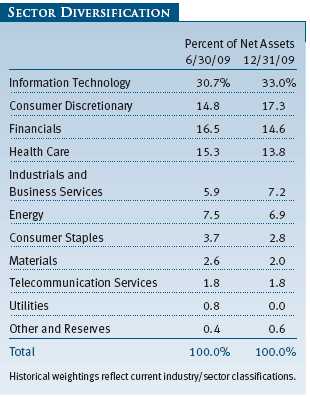
Despite the fund’s strong performance, we owned several stocks that performed poorly. St. Jude Medical was our largest detractor for the last six months, although it had a gain for the year. The company is a leading provider of implantable cardiac defibrillators, pacemakers, and other cardiology and neurology devices. The company suffered as health care reform concerns, including a proposed tax on device companies, weighed on the stock. The company has had a solid record of growth over time but executed poorly in several areas. Consequently, we sold a portion of our position but have been encouraged with some of the remedial steps the company is taking. Gilead Sciences, another major detractor, was hurt by a few product disappointments. The company also faces a patent expiration on a key product, but it has had some success in moving the next generation of that product through the approval process. We have trimmed small amounts of this large holding from time to time, but we continue to be constructive on its growth prospects.
Our greatest disappointment in the second half was the poor performance of trust bank holdings State Street and Northern Trust, which performed much worse than we expected given the strong rebound in the stock market and their assets under custody and under management. Their profitability was hurt by large reductions in securities lending activities, subdued foreign exchange trading activity, and the very low interest rate level, which led to significant fee waivers on money market funds. As these negative factors became apparent, we reduced our positions in these stocks. Lockheed Martin was also a poor performer due to profit shortfalls in certain businesses. Investors also realized that defense programs and expenditures are being very closely scrutinized, and in some cases may be curtailed, given budgetary problems. We have eliminated Lockheed Martin and invested the proceeds in other aerospace or industrial companies.
STRATEGY
Additions to existing holdings such as Google, PepsiCo, EOG Resources, and Procter & Gamble were among our 10 largest purchases for the past six months. We also initiated several new positions. IBM generates most of its profits from software and services and has been steadily improving its operating margins. The company should benefit from stimulus and infrastructure spending and has expanded its presence in energy and productivity management solutions. We believe the company could continue to prosper even if the economy does not experience a robust recovery. The stock has lagged in the market recovery and is one of our analysts’ favorite ideas, leading us to buy a moderately sized position. A new position in 3M provided a solid performance contribution. The company has executed well despite the turbulent market environment. Management appears to have reinvigorated the company, and its historically strong profitability is now being augmented by much better product innovation and growth. Our third-largest new position, Starbucks, performed well as consumer confidence and discretionary purchasing recovered. An important reengineering is also occurring at the company, resulting in much more effective expense management and rapidly expanding profit margins, especially in its international operations. We used the market weakness to accumulate a position in Walt Disney as we believe many of its businesses such as ESPN are high quality and underappreciated by the market. It also provided a good performance contribution during the period.
The other new positions we established in the last six months, Precision Castparts and United Technologies, are leaders in the aerospace industry. Both companies performed well through the recession and have among the best records of long-term profit growth in the industrials sector. A recovery in world air travel would be particularly helpful for Precision Castparts, which forges or casts highly technical parts used in aerospace and other applications. We were quite impressed in our recent meeting with the CEO, and we now better understand why this company has been run so efficiently for many years. United Technologies is a more diversified company, and we think its Pratt, Otis, and Carrier divisions will benefit from continued recovery in aerospace, infrastructure spending, and residential construction. The company is also well diversified by geography with very powerful market positions in several Asian countries, including China.
Our largest sales included the elimination of Research In Motion, which was sold for a substantial profit following a relatively short holding period. We typically hold stocks for several years. However, we purchased the stock at what we believed was a very attractive price in the midst of the market sell-off. While we consider it to be a quality growth company, we became concerned that it ultimately would not be as successful in the consumer market as it has been in providing devices for corporate customers. When the stock appreciated very sharply over several quarters—and as Apple and others continued to make competitive inroads—we elected to eliminate the position. As noted earlier, we also eliminated Lockheed Martin due to profit shortfalls and growing concerns about the potential downsizing of certain defense expenditures and programs.
We sold a portion of our position in Wal-Mart. The company did not execute as well as we had hoped during 2009, particularly as the economy began to recover. We still have a stake in the company, but we believe other alternatives in the retail area appear somewhat more attractive. We also trimmed our large position in Amazon. We were patient with this well-managed and rapidly growing company, and the sales were made after the stock generated substantial gains. However, upward profit revisions following our stock sales have been significant and support continued ownership of the stock. The company grew its profits well over 30% through the recession, and expansion in Internet-based retailing could continue for some time. Although the stock’s valuation is expensive, it trades at less than 20 times our estimate of free cash flow per share in 2011. Amazon was the portfolio’s third-largest holding at the end of the year, behind Apple and Google.
OUTLOOK
An unprecedented crisis in credit and financial markets has now been followed by a historic rebound in global stock markets. This has been accompanied by some improvement in retail and auto sales, housing, and manufacturing, which provide increased confidence that an economic recovery is in progress. However, the pace and durability of the improvement and also the unintended consequences of aggressive monetary and fiscal policy (such as increased inflation) continue to be difficult to discern. As we noted in our last letter, economic healing will take time and require natural economic forces to play out. Stimulus programs can be helpful, but private enterprise and time ultimately will be required to bring about lasting prosperity.
Despite the frailty of the economic recovery and the many uncertainties facing investors, we continue to be optimistic about the long-term performance of stocks. Our primary reservations are that financial markets have already experienced a strong recovery. Nevertheless, some stocks appear reasonably valued, even after the strong recent gains. We are also concerned that government spending and regulation may not be pursued in a way that would yield the greatest benefit to the economy. However, we accept that some government actions will not achieve their objectives—public or private sector solutions are not perfect. We also believe that the dangers of overregulation or unrestrained spending and deficits are receiving more attention and emphasis as the economy recovers. Certain holdings undoubtedly will benefit from the stimulus plan and other government initiatives.
Despite the uncertainty surrounding how effective fiscal and monetary actions will be in healing the economy, there are several things working in our favor:
1. Stocks historically have performed quite well following a lack-luster 10-year period of performance. Essentially, we have experienced two very major bear markets in the past 10 years.
2. Stock valuations are attractive, especially in relation to today’s low interest rates. Although interest rates have risen moderately, the difference between the earnings yield on stocks and the 10-year Treasury rate is attractive in any historical context.
3. We believe the high-quality, consistent-growth companies that we seek to purchase are attractive and could conceivably perform well even if the economy only experiences a modest recovery.
4. Many large-cap growth companies have strong balance sheets with record amounts of cash and strong capitalization. This should allow them to manage through challenges and be opportunistic in investing in products or acquiring other businesses as change creates dislocation.
5. Many of our holdings generate significant free cash flow. Shareholder-oriented managements can use this cash to increase dividends (which receive more favorable tax treatment than they did a few years ago), repurchase shares, or make value-added acquisitions.
We continue to strive to enhance returns in a challenging environment by investing in quality companies with durable, sustainable earnings and cash flow growth. We appreciate your continued confidence in this endeavor.
Respectfully submitted,

Larry J. Puglia
President and chairman of the Investment Advisory Committee
January 12, 2010
The committee chairman has day-to-day responsibility for managing the portfolio and works with committee members in developing and executing the fund’s investment program.
RISKS OF STOCK INVESTING
The fund’s share price can fall because of weakness in the stock markets, a particular industry, or specific holdings. Stock markets can decline for many reasons, including adverse political or economic developments, changes in investor psychology, or heavy institutional selling. The prospects for an industry or company may deteriorate because of a variety of factors, including disappointing earnings or changes in the competitive environment. In addition, the investment manager’s assessment of companies held in a fund may prove incorrect, resulting in losses or poor performance even in rising markets. Growth stocks can be volatile because these companies usually invest a high portion of earnings in their businesses, and earnings disappointments often lead to sharply falling prices. The value approach carries the risk that a security’s intrinsic value may not be recognized for a long time or that the stock may actually be appropriately priced.
GLOSSARY
Dividend yield: The annual dividend of a stock divided by the stock’s price.
Free cash flow: The excess cash a company is generating from its operations that can be taken out of the business for the benefit of shareholders, such as dividends, share repurchases, investments, and acquisitions.
Lipper indexes: Fund benchmarks that consist of a small number (10 to 30) of the largest mutual funds in a particular category as tracked by Lipper Inc.
Price/book ratio: A valuation measure that compares a stock’s market price with its book value, i.e., the company’s net worth divided by the number of outstanding shares.
Price/earnings (P/E) ratio: A valuation measure calculated by dividing the price of a stock by its current or projected earnings per share. This ratio gives investors an idea of how much they are paying for current or future earnings power.
Russell 1000 Growth Index: A market capitalization-weighted index of those firms in the Russell 1000 with higher price-to-book ratios and higher forecasted growth values.
S&P 500 Index: An unmanaged index that tracks the stocks of 500 primarily large-cap U.S. companies.
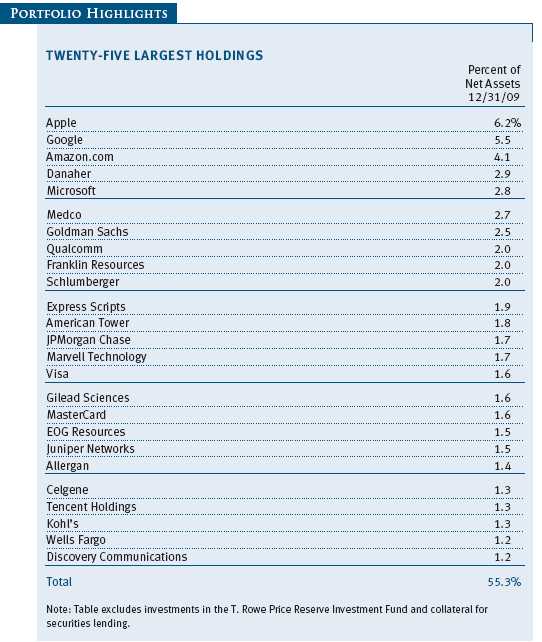
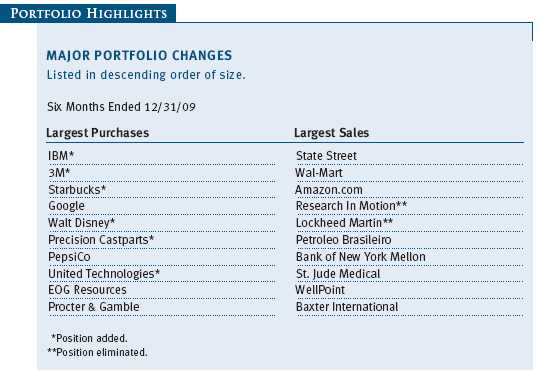
Performance and Expenses
| GROWTH OF $10,000 |
This chart shows the value of a hypothetical $10,000 investment in the fund over the past 10 fiscal year periods or since inception (for funds lacking 10-year records). The result is compared with benchmarks, which may include a broad-based market index and a peer group average or index. Market indexes do not include expenses, which are deducted from fund returns as well as mutual fund averages and indexes.
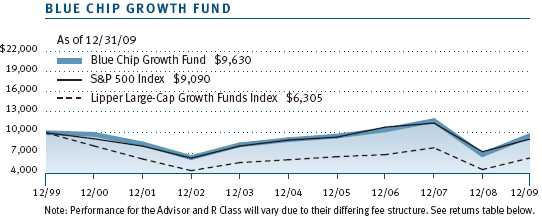
| AVERAGE ANNUAL COMPOUND TOTAL RETURN |
This table shows how the fund would have performed each year if its actual (or cumulative) returns had been earned at a constant rate.
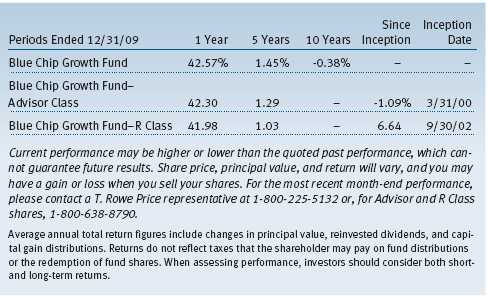

| FUND EXPENSE EXAMPLE |
As a mutual fund shareholder, you may incur two types of costs: (1) transaction costs, such as redemption fees or sales loads, and (2) ongoing costs, including management fees, distribution and service (12b-1) fees, and other fund expenses. The following example is intended to help you understand your ongoing costs (in dollars) of investing in the fund and to compare these costs with the ongoing costs of investing in other mutual funds. The example is based on an investment of $1,000 invested at the beginning of the most recent six-month period and held for the entire period.
Please note that the fund has three share classes: The original share class (“investor class”) charges no distribution and service (12b-1) fee, Advisor Class shares are offered only through unaffiliated brokers and other financial intermediaries and charge a 0.25% 12b-1 fee, and R Class shares are available to retirement plans serviced by intermediaries and charge a 0.50% 12b-1 fee. Each share class is presented separately in the table.
Actual Expenses
The first line of the following table (“Actual”) provides information about actual account values and expenses based on the fund’s actual returns. You may use the information in this line, together with your account balance, to estimate the expenses that you paid over the period. Simply divide your account value by $1,000 (for example, an $8,600 account value divided by $1,000 = 8.6), then multiply the result by the number in the first line under the heading “Expenses Paid During Period” to estimate the expenses you paid on your account during this period.
Hypothetical Example for Comparison Purposes
The information on the second line of the table (“Hypothetical”) is based on hypothetical account values and expenses derived from the fund’s actual expense ratio and an assumed 5% per year rate of return before expenses (not the fund’s actual return). You may compare the ongoing costs of investing in the fund with other funds by contrasting this 5% hypothetical example and the 5% hypothetical examples that appear in the shareholder reports of the other funds. The hypothetical account values and expenses may not be used to estimate the actual ending account balance or expenses you paid for the period.
Note: T. Rowe Price charges an annual small-account maintenance fee of $10, generally for accounts with less than $2,000 ($500 for UGMA/UTMA). The fee is waived for any investor whose T. Rowe Price mutual fund accounts total $25,000 or more, accounts employing automatic investing, and IRAs and other retirement plan accounts that utilize a prototype plan sponsored by T. Rowe Price (although a separate custodial or administrative fee may apply to such accounts). This fee is not included in the accompanying table. If you are subject to the fee, keep it in mind when you are estimating the ongoing expenses of investing in the fund and when comparing the expenses of this fund with other funds.
You should also be aware that the expenses shown in the table highlight only your ongoing costs and do not reflect any transaction costs, such as redemption fees or sales loads. Therefore, the second line of the table is useful in comparing ongoing costs only and will not help you determine the relative total costs of owning different funds. To the extent a fund charges transaction costs, however, the total cost of owning that fund is higher.
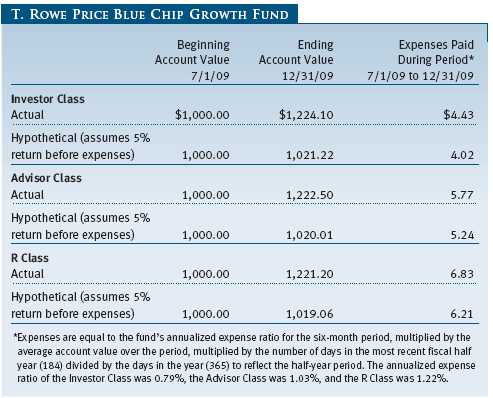
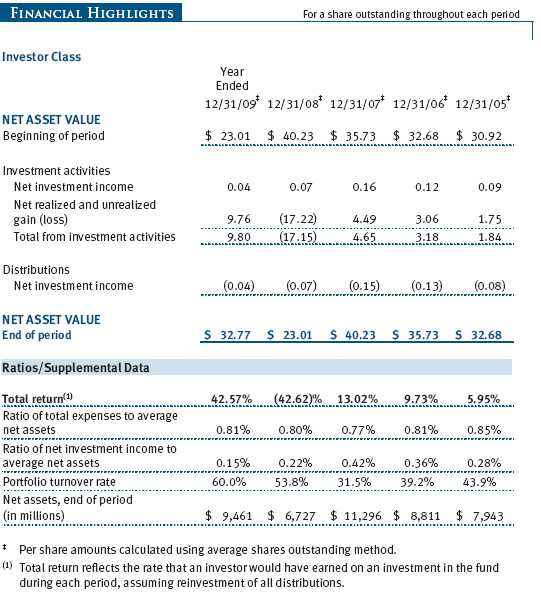
The accompanying notes are an integral part of these financial statements.
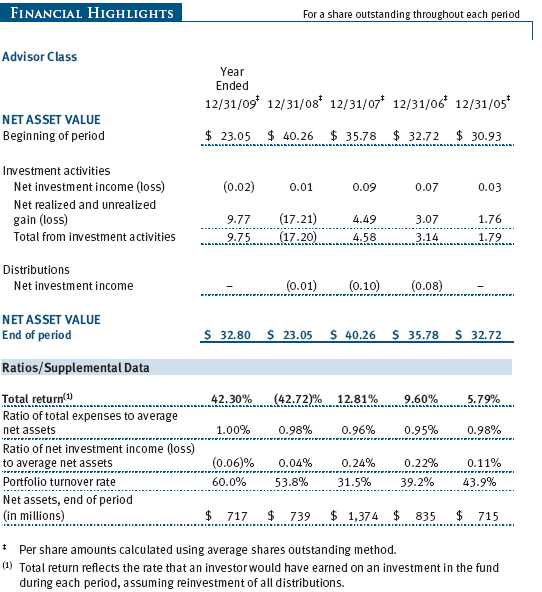
The accompanying notes are an integral part of these financial statements.
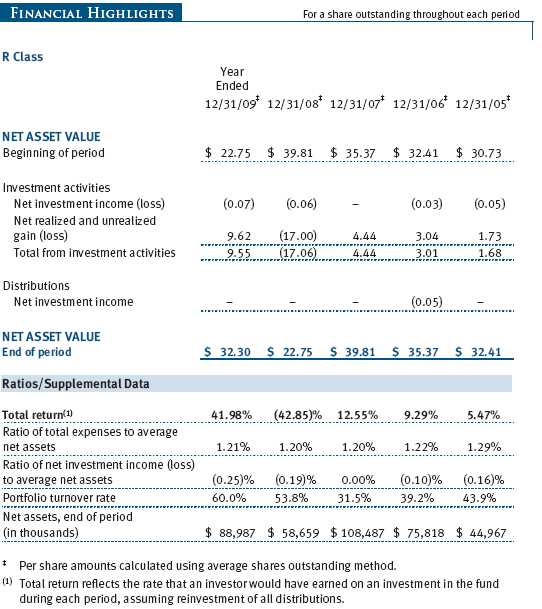
The accompanying notes are an integral part of these financial statements.

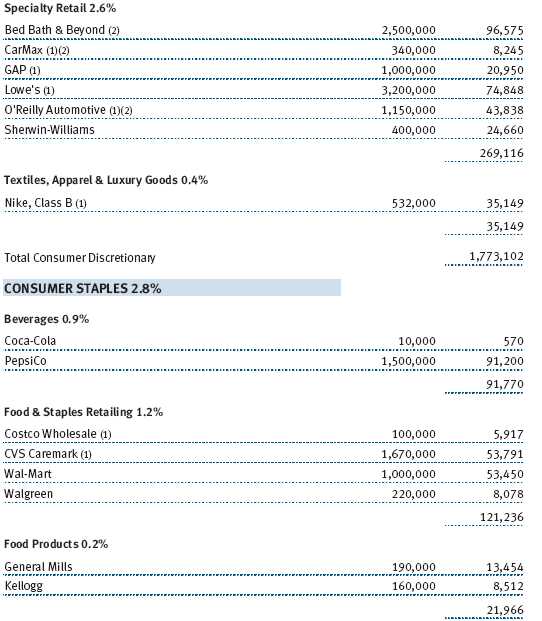
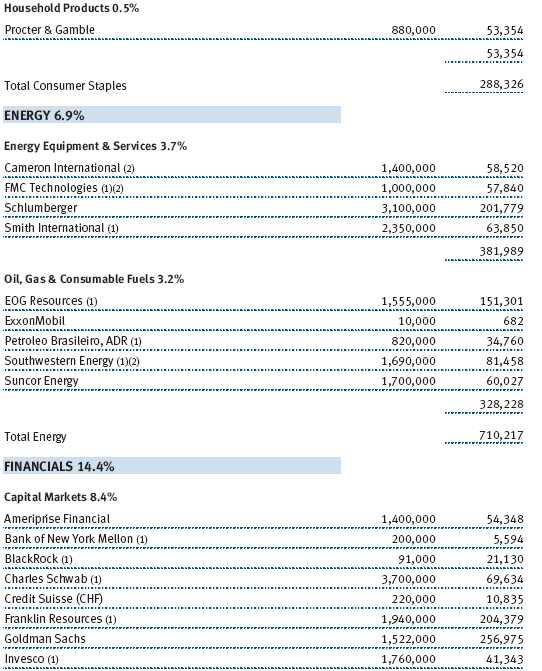

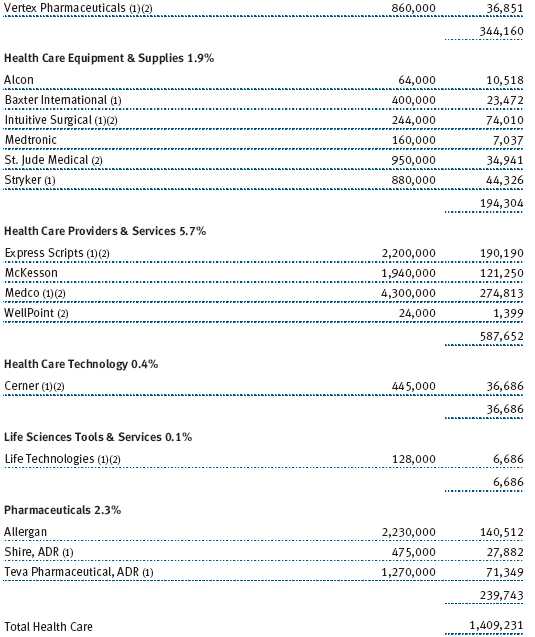
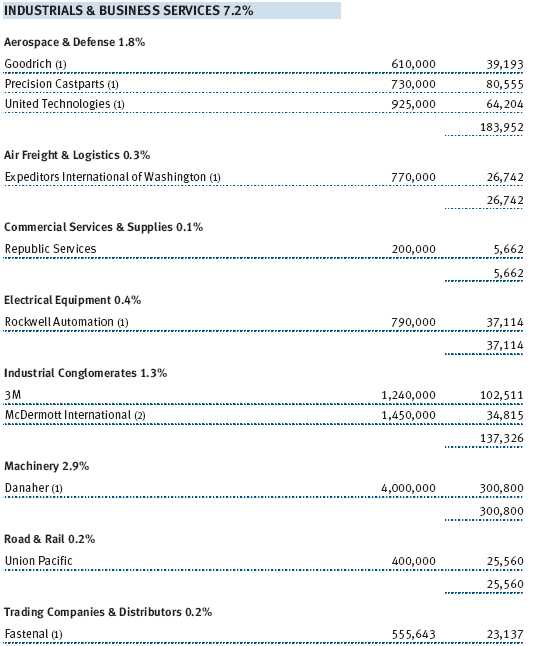
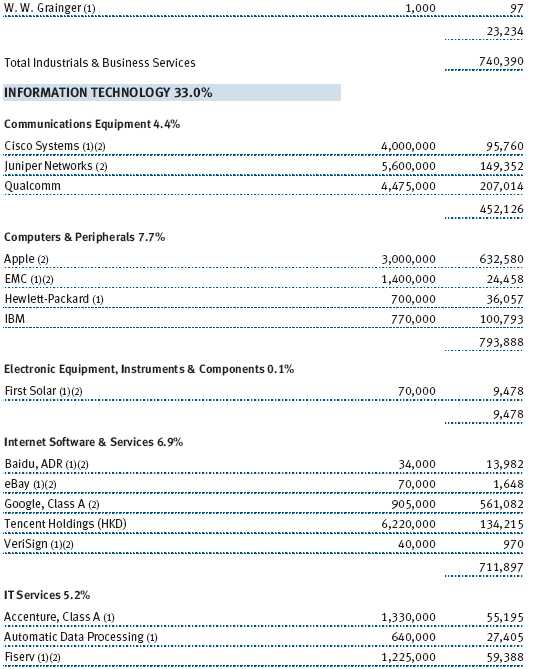
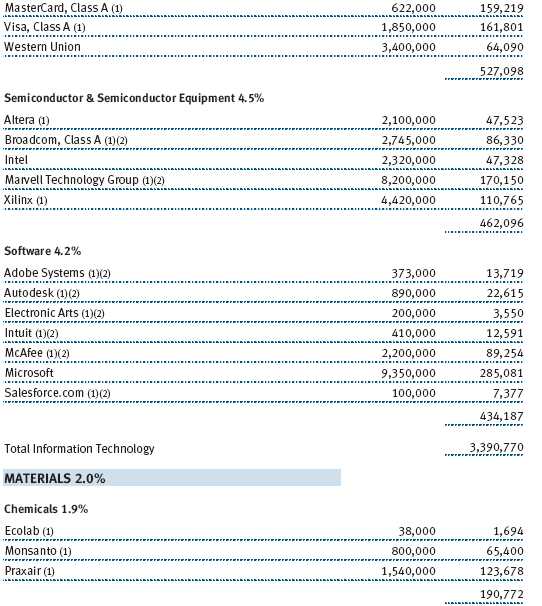
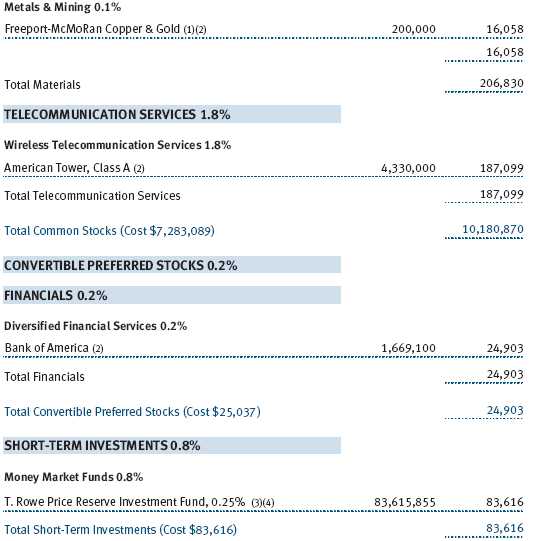
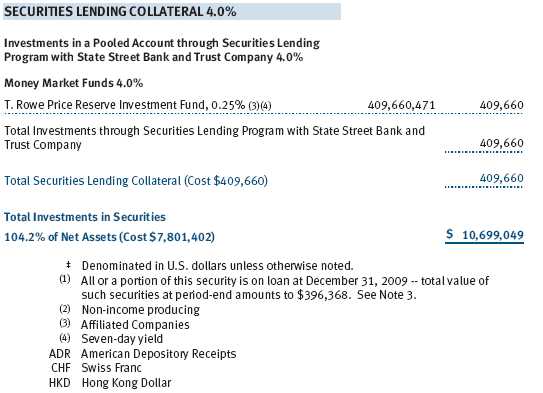
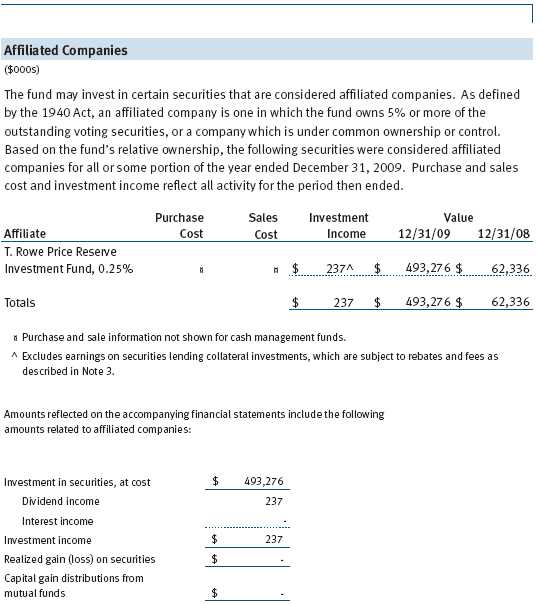
The accompanying notes are an integral part of these financial statements.
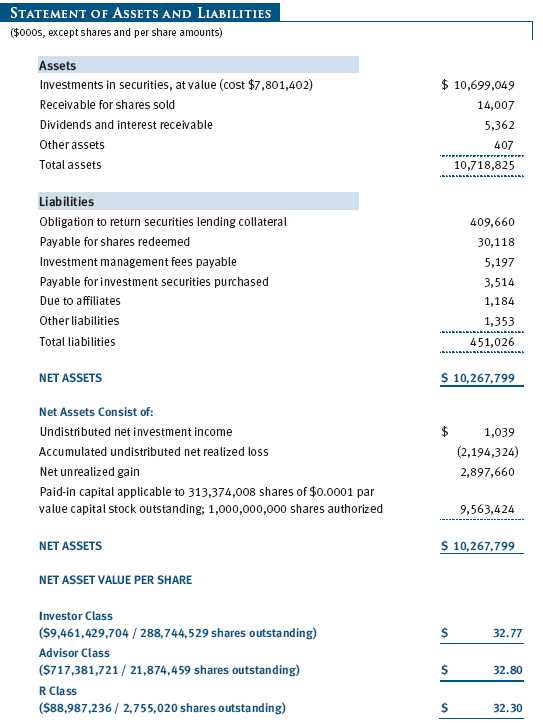
The accompanying notes are an integral part of these financial statements.
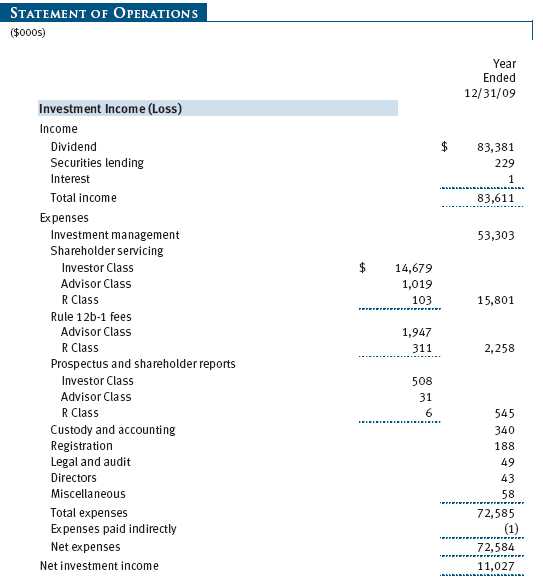
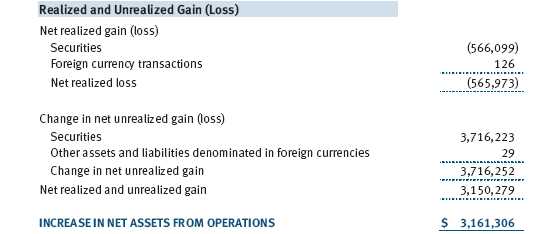
The accompanying notes are an integral part of these financial statements.
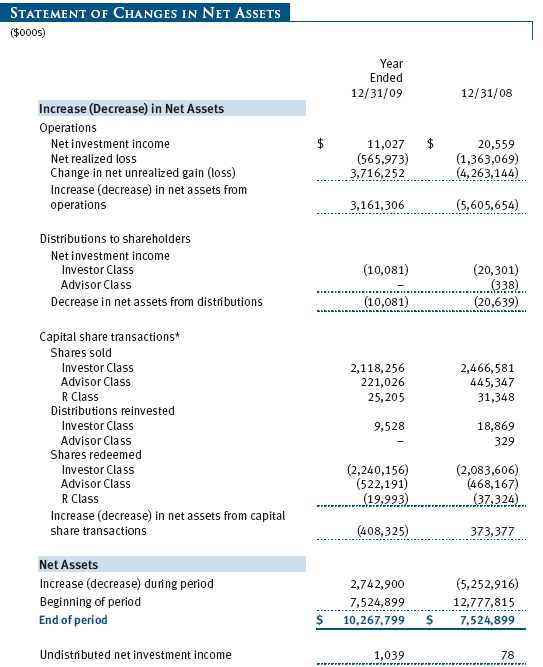
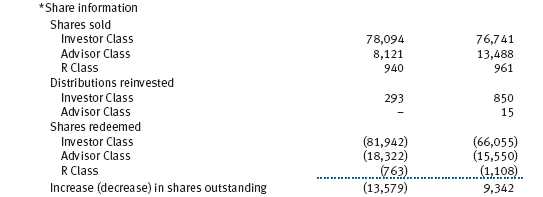
The accompanying notes are an integral part of these financial statements.
| NOTES TO FINANCIAL STATEMENTS |
T. Rowe Price Blue Chip Growth Fund, Inc. (the fund), is registered under the Investment Company Act of 1940 (the 1940 Act) as a diversified, open-end management investment company. The fund seeks to provide long-term capital growth. Income is a secondary objective. The fund has three classes of shares: the Blue Chip Growth Fund original share class, referred to in this report as the Investor Class, offered since June 30, 1993; the Blue Chip Growth Fund—Advisor Class (Advisor Class), offered since March 31, 2000; and the Blue Chip Growth Fund—R Class (R Class), offered since September 30, 2002. Advisor Class shares are sold only through unaffiliated brokers and other unaffiliated financial intermediaries, and R Class shares are available to retirement plans serviced by intermediaries. The Advisor Class and R Class each operate under separate Board-approved Rule 12b-1 plans, pursuant to which each class compensates financial intermediaries for distribution, shareholder servicing, and/or certain administrative services. Each class has exclusive voting rights on matters related solely to that class; separate voting rights on matters that relate to all classes; and, in all other respects, the same rights and obligations as the other classes.
NOTE 1 - SIGNIFICANT ACCOUNTING POLICIES
Basis of Preparation The accompanying financial statements were prepared in accordance with accounting principles generally accepted in the United States of America (GAAP), which require the use of estimates made by fund management. Fund management believes that estimates and security valuations are appropriate; however, actual results may differ from those estimates, and the security valuations reflected in the accompanying financial statements may differ from the value ultimately realized upon sale of the securities. Further, fund management believes that no events have occurred between December 31, 2009, the date of this report, and February 25, 2010, the date of issuance of the financial statements, that require adjustment of, or disclosure in, the accompanying financial statements.
Investment Transactions, Investment Income, and Distributions Income and expenses are recorded on the accrual basis. Dividends received from mutual fund investments are reflected as dividend income; capital gain distributions are reflected as realized gain/loss. Dividend income and capital gain distributions are recorded on the ex-dividend date. Income tax-related interest and penalties, if incurred, would be recorded as income tax expense. Investment transactions are accounted for on the trade date. Realized gains and losses are reported on the identified cost basis. Distributions to shareholders are recorded on the ex-dividend date. Income distributions are declared and paid by each class annually. Capital gain distributions, if any, are generally declared and paid by the fund, annually.
Currency Translation Assets, including investments, and liabilities denominated in foreign currencies are translated into U.S. dollar values each day at the prevailing exchange rate, using the mean of the bid and asked prices of such currencies against U.S. dollars as quoted by a major bank. Purchases and sales of securities, income, and expenses are translated into U.S. dollars at the prevailing exchange rate on the date of the transaction. The effect of changes in foreign currency exchange rates on realized and unrealized security gains and losses is reflected as a component of security gains and losses.
Class Accounting The Advisor Class and R Class each pay distribution, shareholder servicing, and/or certain administrative expenses in the form of Rule 12b-1 fees, in an amount not exceeding 0.25% and 0.50%, respectively, of the class’s average daily net assets. Shareholder servicing, prospectus, and shareholder report expenses incurred by each class are charged directly to the class to which they relate. Expenses common to all classes, investment income, and realized and unrealized gains and losses are allocated to the classes based upon the relative daily net assets of each class.
Rebates and Credits Subject to best execution, the fund may direct certain security trades to brokers who have agreed to rebate a portion of the related brokerage commission to the fund in cash. Commission rebates are reflected as realized gain on securities in the accompanying financial statements and totaled $327,000 for the year ended December 31, 2009. Additionally, the fund earns credits on temporarily uninvested cash balances held at the custodian, which reduce the fund’s custody charges. Custody expense in the accompanying financial statements is presented before reduction for credits, which are reflected as expenses paid indirectly.
In-Kind Redemptions In accordance with guidelines described in the fund’s prospectus, the fund may distribute portfolio securities rather than cash as payment for a redemption of fund shares (in-kind redemption). For financial reporting purposes, the fund recognizes a gain on in-kind redemptions to the extent the value of the distributed securities on the date of redemption exceeds the cost of those securities. Gains and losses realized on in-kind redemptions are not recognized for tax purposes and are reclassified from undistributed realized gain (loss) to paid-in capital. During the year ended December 31, 2009, the fund realized $211,393,000 of net gain on $451,542,000 of in-kind redemptions.
New Accounting Pronouncement On January 1, 2009, the fund adopted new accounting guidance that requires enhanced disclosures about derivative and hedging activities, including how such activities are accounted for and their effect on financial position, performance, and cash flows. Adoption of this guidance had no impact on the fund’s net assets or results of operations.
NOTE 2 - VALUATION
The fund’s investments are reported at fair value as defined under GAAP. The fund determines the values of its assets and liabilities and computes its net asset value per share at the close of the New York Stock Exchange (NYSE), normally 4 p.m. ET, each day that the NYSE is open for business.
Valuation Methods Equity securities listed or regularly traded on a securities exchange or in the over-the-counter (OTC) market are valued at the last quoted sale price or, for certain markets, the official closing price at the time the valuations are made, except for OTC Bulletin Board securities, which are valued at the mean of the latest bid and asked prices. A security that is listed or traded on more than one exchange is valued at the quotation on the exchange determined to be the primary market for such security. Listed securities not traded on a particular day are valued at the mean of the latest bid and asked prices for domestic securities and the last quoted sale price for international securities.
Investments in mutual funds are valued at the mutual fund’s closing net asset value per share on the day of valuation.
Other investments, including restricted securities, and those financial instruments for which the above valuation procedures are inappropriate or are deemed not to reflect fair value are stated at fair value as determined in good faith by the T. Rowe Price Valuation Committee, established by the fund’s Board of Directors.
For valuation purposes, the last quoted prices of non-U.S. equity securities may be adjusted under the circumstances described below. If the fund determines that developments between the close of a foreign market and the close of the NYSE will, in its judgment, materially affect the value of some or all of its portfolio securities, the fund will adjust the previous closing prices to reflect what it believes to be the fair value of the securities as of the close of the NYSE. In deciding whether it is necessary to adjust closing prices to reflect fair value, the fund reviews a variety of factors, including developments in foreign markets, the performance of U.S. securities markets, and the performance of instruments trading in U.S. markets that represent foreign securities and baskets of foreign securities. A fund may also fair value securities in other situations, such as when a particular foreign market is closed but the fund is open. The fund uses outside pricing services to provide it with closing prices and information to evaluate and/or adjust those prices. The fund cannot predict how often it will use closing prices and how often it will determine it necessary to adjust those prices to reflect fair value. As a means of evaluating its security valuation process, the fund routinely compares closing prices, the next day’s opening prices in the same markets, and adjusted prices.
Valuation Inputs Various inputs are used to determine the value of the fund’s financial instruments. These inputs are summarized in the three broad levels listed below:
Level 1 – quoted prices in active markets for identical securities
Level 2 – observable inputs other than Level 1 quoted prices (including, but not limited to, quoted prices for similar securities, interest rates, prepayment speeds, and credit risk)
Level 3 – unobservable inputs
Observable inputs are those based on market data obtained from sources independent of the fund, and unobservable inputs reflect the fund’s own assumptions based on the best information available. The input levels are not necessarily an indication of the risk or liquidity associated with financial instruments at that level. For example, non-U.S. equity securities actively traded in foreign markets generally are reflected in Level 2 despite the availability of closing prices because the fund evaluates and determines whether those closing prices reflect fair value at the close of the NYSE or require adjustment, as described above. The following table summarizes the fund’s financial instruments, based on the inputs used to determine their values on December 31, 2009:
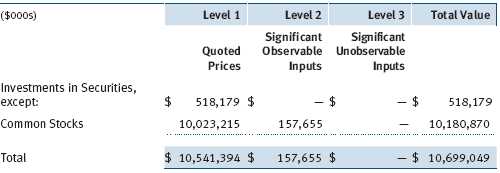
NOTE 3 - OTHER INVESTMENT TRANSACTIONS
Consistent with its investment objective, the fund engages in the following practices to manage exposure to certain risks and/or to enhance performance. The investment objective, policies, program, and risk factors of the fund are described more fully in the fund’s prospectus and Statement of Additional Information.
Securities Lending The fund lends its securities to approved brokers to earn additional income. It receives as collateral cash and U.S. government securities valued at 102% to 105% of the value of the securities on loan. Cash collateral is invested by the fund’s lending agent(s) in accordance with investment guidelines approved by fund management. Although risk is mitigated by the collateral, the fund could experience a delay in recovering its securities and a possible loss of income or value if the borrower fails to return the securities or if collateral investments decline in value. Securities lending revenue recognized by the fund consists of earnings on invested collateral and borrowing fees, net of any rebates to the borrower and compensation to the lending agent. On December 31, 2009, the value of loaned securities was $396,368,000; aggregate collateral received included U.S. government securities valued at $74,000.
Other Purchases and sales of portfolio securities other than short-term securities aggregated $5,195,577,000 and $5,604,279,000, respectively, for the year ended December 31, 2009.
NOTE 4 - FEDERAL INCOME TAXES
No provision for federal income taxes is required since the fund intends to continue to qualify as a regulated investment company under Subchapter M of the Internal Revenue Code and distribute to shareholders all of its taxable income and gains. Distributions determined in accordance with federal income tax regulations may differ in amount or character from net investment income and realized gains for financial reporting purposes. Financial reporting records are adjusted for permanent book/tax differences to reflect tax character but are not adjusted for temporary differences.
The fund files U.S. federal, state, and local tax returns as required. The fund’s tax returns are subject to examination by the relevant tax authorities until expiration of the applicable statute of limitations, which is generally three years after filing of the tax return but could be longer in certain circumstances.
Reclassifications to paid-in capital relate primarily to redemptions in kind. For the year ended December 31, 2009, the following reclassifications were recorded to reflect tax character; there was no impact on results of operations or net assets:

Distributions during the years ended December 31, 2009 and December 31, 2008, totaled $10,081,000 and $20,639,000, respectively, and were characterized as ordinary income for tax purposes. At December 31, 2009, the tax-basis cost of investments and components of net assets were as follows:
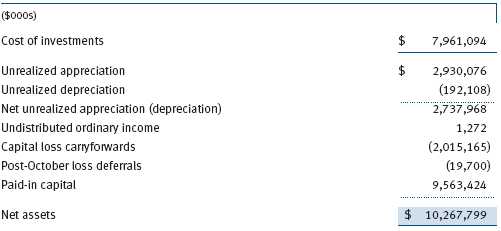
The difference between book-basis and tax-basis net unrealized appreciation (depreciation) is attributable to the deferral of losses from wash sales for tax purposes. The fund intends to retain realized gains to the extent of available capital loss carryforwards. The fund’s unused capital loss carryforwards as of December 31, 2009, expire: $74,856,000 in fiscal 2011, $695,846,000 in fiscal 2016, and $1,244,463,000 in fiscal 2017. In accordance with federal income tax regulations applicable to investment companies, recognition of capital losses on certain transactions realized between November 1 and the fund’s fiscal year end is deferred for tax purposes until the subsequent year (post-October loss deferrals); however, such losses are recognized for financial reporting purposes in the year realized.
NOTE 5 - RELATED PARTY TRANSACTIONS
The fund is managed by T. Rowe Price Associates, Inc. (the manager or Price Associates), a wholly owned subsidiary of T. Rowe Price Group, Inc. The investment management agreement between the fund and the manager provides for an annual investment management fee, which is computed daily and paid monthly. The fee consists of an individual fund fee, equal to 0.30% of the fund’s average daily net assets, and a group fee. The group fee rate is calculated based on the combined net assets of certain mutual funds sponsored by Price Associates (the group) applied to a graduated fee schedule, with rates ranging from 0.48% for the first $1 billion of assets to 0.285% for assets in excess of $220 billion. The fund’s group fee is determined by applying the group fee rate to the fund’s average daily net assets. At December 31, 2009, the effective annual group fee rate was 0.30%.
In addition, the fund has entered into service agreements with Price Associates and two wholly owned subsidiaries of Price Associates (collectively, Price). Price Associates computes the daily share prices and provides certain other administrative services to the fund. T. Rowe Price Services, Inc., provides shareholder and administrative services in its capacity as the fund’s transfer and dividend disbursing agent. T. Rowe Price Retirement Plan Services, Inc., provides subaccounting and recordkeeping services for certain retirement accounts invested in the Investor Class and R Class. For the year ended December 31, 2009, expenses incurred pursuant to these service agreements were $98,000 for Price Associates; $3,251,000 for T. Rowe Price Services, Inc.; and $5,064,000 for T. Rowe Price Retirement Plan Services, Inc. The total amount payable at period-end pursuant to these service agreements is reflected as Due to Affiliates in the accompanying financial statements.
Additionally, the fund is one of several mutual funds in which certain college savings plans managed by Price Associates may invest. As approved by the fund’s Board of Directors, shareholder servicing costs associated with each college savings plan are borne by the fund in proportion to the average daily value of its shares owned by the college savings plan. For the year ended December 31, 2009, the fund was charged $848,000 for shareholder servicing costs related to the college savings plans, of which $641,000 was for services provided by Price. The amount payable at period-end pursuant to this agreement is reflected as Due to Affiliates in the accompanying financial statements. At December 31, 2009, approximately 4% of the outstanding shares of the Investor Class were held by college savings plans.
The fund is also one of several mutual funds sponsored by Price Associates (underlying Price funds) in which the T. Rowe Price Spectrum Funds (Spectrum Funds) may invest. The Spectrum Funds do not invest in the underlying Price funds for the purpose of exercising management or control. Pursuant to a special servicing agreement, expenses associated with the operation of the Spectrum Funds are borne by each underlying Price fund to the extent of estimated savings to it and in proportion to the average daily value of its shares owned by the Spectrum Funds. Expenses allocated under this agreement are reflected as shareholder servicing expense in the accompanying financial statements. For the year ended December 31, 2009, the fund was allocated $711,000 of Spectrum Funds’ expenses, of which $487,000 related to services provided by Price. The amount payable at period-end pursuant to this agreement is reflected as Due to Affiliates in the accompanying financial statements. At December 31, 2009, approximately 5% of the outstanding shares of the Investor Class were held by the Spectrum Funds.
The fund may invest in the T. Rowe Price Reserve Investment Fund and the T. Rowe Price Government Reserve Investment Fund (collectively, the T. Rowe Price Reserve Investment Funds), open-end management investment companies managed by Price Associates and considered affiliates of the fund. The T. Rowe Price Reserve Investment Funds are offered as cash management options to mutual funds, trusts, and other accounts managed by Price Associates and/or its affiliates and are not available for direct purchase by members of the public. The T. Rowe Price Reserve Investment Funds pay no investment management fees.
| REPORT OF INDEPENDENT REGISTERED PUBLIC ACCOUNTING FIRM |
To the Board of Directors and Shareholders of
T. Rowe Price Blue Chip Growth Fund, Inc.
In our opinion, the accompanying statement of assets and liabilities, including the schedule of investments, and the related statements of operations and of changes in net assets and the financial highlights present fairly, in all material respects, the financial position of T. Rowe Price Blue Chip Growth Fund, Inc. (the “Fund”) at December 31, 2009, the results of its operations for the year then ended, the changes in its net assets for each of the two years in the period then ended and the financial highlights for each of the five years in the period then ended, in conformity with accounting principles generally accepted in the United States of America. These financial statements and financial highlights (hereafter referred to as “financial statements”) are the responsibility of the Fund’s management; our responsibility is to express an opinion on these financial statements based on our audits. We conducted our audits of these financial statements in accordance with the standards of the Public Company Accounting Oversight Board (United States). Those standards require that we plan and perform the audit to obtain reasonable assurance about whether the financial statements are free of material misstatement. An audit includes examining, on a test basis, evidence supporting the amounts and disclosures in the financial statements, assessing the accounting principles used and significant estimates made by management, and evaluating the overall financial statement presentation. We believe that our audits, which included confirmation of securities at December 31, 2009 by correspondence with the custodian, and confirmation of the underlying fund by correspondence with the transfer agent, provide a reasonable basis for our opinion.
PricewaterhouseCoopers LLP
Baltimore, Maryland
February 25, 2010
| TAX INFORMATION (UNAUDITED) FOR THE TAX YEAR ENDED 12/31/09 |
We are providing this information as required by the Internal Revenue Code. The amounts shown may differ from those elsewhere in this report because of differences between tax and financial reporting requirements.
For taxable non-corporate shareholders, $11,172,000 of the fund’s income represents qualified dividend income subject to the 15% rate category.
For corporate shareholders, $11,172,000 of the fund’s income qualifies for the dividends-received deduction.
| INFORMATION ON PROXY VOTING POLICIES, PROCEDURES, AND RECORDS |
A description of the policies and procedures used by T. Rowe Price funds and portfolios to determine how to vote proxies relating to portfolio securities is available in each fund’s Statement of Additional Information, which you may request by calling 1-800-225-5132 or by accessing the SEC’s Web site, www.sec.gov. The description of our proxy voting policies and procedures is also available on our Web site, www.troweprice.com. To access it, click on the words “Our Company” at the top of our corporate homepage. Then, when the next page appears, click on the words “Proxy Voting Policies” on the left side of the page.
Each fund’s most recent annual proxy voting record is available on our Web site and through the SEC’s Web site. To access it through our Web site, follow the directions above, then click on the words “Proxy Voting Records” on the right side of the Proxy Voting Policies page.
| HOW TO OBTAIN QUARTERLY PORTFOLIO HOLDINGS |
The fund files a complete schedule of portfolio holdings with the Securities and Exchange Commission for the first and third quarters of each fiscal year on Form N-Q. The fund’s Form N-Q is available electronically on the SEC’s Web site (www.sec.gov); hard copies may be reviewed and copied at the SEC’s Public Reference Room, 450 Fifth St. N.W., Washington, DC 20549. For more information on the Public Reference Room, call 1-800-SEC-0330.
| ABOUT THE FUND’S DIRECTORS AND OFFICERS |
Your fund is governed by a Board of Directors (Board) that meets regularly to review a wide variety of matters affecting the fund, including performance, investment programs, compliance matters, advisory fees and expenses, service providers, and other business affairs. The Board elects the fund’s officers, who are listed in the final table. At least 75% of Board members are independent of T. Rowe Price Associates, Inc. (T. Rowe Price), and T. Rowe Price International, Inc. (T. Rowe Price International); “inside” or “interested” directors are employees or officers of T. Rowe Price. The business address of each director and officer is 100 East Pratt Street, Baltimore, Maryland 21202. The Statement of Additional Information includes additional information about the directors and is available without charge by calling a T. Rowe Price representative at 1-800-225-5132.
| Independent Directors | |
| Name | |
| (Year of Birth) | Principal Occupation(s) During Past Five Years and Directorships of |
| Year Elected* | Other Public Companies |
| William R. Brody, M.D., | President and Trustee, Salk Institute for Biological Studies (2009 |
| Ph.D. | to present); Director, Novartis, Inc. (2009 to present); Director, IBM |
| (1944) | (2007 to present); President and Trustee, Johns Hopkins University |
| 2009 | (1996 to 2009); Chairman of Executive Committee and Trustee, |
| Johns Hopkins Health System (1996 to 2009) | |
| Jeremiah E. Casey | Director, National Life Insurance (2001 to 2005); Director, The Rouse |
| (1940) | Company, real estate developers (1990 to 2004) |
| 2005 | |
| Anthony W. Deering | Chairman, Exeter Capital, LLC, a private investment firm (2004 to |
| (1945) | present); Director, Under Armour (2008 to present); Director, Vornado |
| 2001 | Real Estate Investment Trust (2004 to present); Director, Mercantile |
| Bankshares (2002 to 2007); Member, Advisory Board, Deutsche Bank | |
| North America (2004 to present); Director, Chairman of the Board, | |
| and Chief Executive Officer, The Rouse Company, real estate develop- | |
| ers (1997 to 2004) | |
| Donald W. Dick, Jr. | Principal, EuroCapital Advisors, LLC, an acquisition and management |
| (1943) | advisory firm (1995 to present) |
| 1993 | |
| Karen N. Horn | Director, Eli Lilly and Company (1987 to present); Director, Simon |
| (1943) | Property Group (2004 to present); Director, Norfolk Southern (2008 |
| 2003 | to present); Director, Georgia Pacific (2004 to 2005) |
| Theo C. Rodgers | President, A&R Development Corporation (1977 to present) |
| (1941) | |
| 2005 | |
| John G. Schreiber | Owner/President, Centaur Capital Partners, Inc., a real estate invest- |
| (1946) | ment company (1991 to present); Partner, Blackstone Real Estate |
| 2001 | Advisors, L.P. (1992 to present) |
| Mark R. Tercek | President and Chief Executive Officer, The Nature Conservancy (2008 |
| (1957) | to present); Managing Director, The Goldman Sachs Group, Inc. |
| 2009 | (1984 to 2008) |
| *Each independent director oversees 124 T. Rowe Price portfolios and serves until retirement, resignation, or | |
| election of a successor. | |
| Inside Directors | |
| Name | |
| (Year of Birth) | |
| Year Elected* | |
| [Number of T. Rowe Price | Principal Occupation(s) During Past Five Years and Directorships of |
| Portfolios Overseen] | Other Public Companies |
| Edward C. Bernard | Director and Vice President, T. Rowe Price; Vice Chairman of the Board, |
| (1956) | Director, and Vice President, T. Rowe Price Group, Inc.; Chairman of |
| 2006 | the Board, Director, and President, T. Rowe Price Investment Services, |
| [124] | Inc.; Chairman of the Board and Director, T. Rowe Price Global Asset |
| Management Limited, T. Rowe Price Global Investment Services | |
| Limited, T. Rowe Price Retirement Plan Services, Inc., T. Rowe Price | |
| Savings Bank, and T. Rowe Price Services, Inc.; Director, T. Rowe Price | |
| International, Inc.; Chief Executive Officer, Chairman of the Board, | |
| Director, and President, T. Rowe Price Trust Company; Chairman of the | |
| Board, all funds | |
| Brian C. Rogers, CFA, CIC | Chief Investment Officer, Director, and Vice President, T. Rowe Price; |
| (1955) | Chairman of the Board, Chief Investment Officer, Director, and Vice |
| 2006 | President, T. Rowe Price Group, Inc.; Vice President, T. Rowe Price |
| [69] | Trust Company |
| *Each inside director serves until retirement, resignation, or election of a successor. | |
| Officers | |
| Name (Year of Birth) | |
| Position Held With Blue Chip Growth Fund | Principal Occupation(s) |
| P. Robert Bartolo, CFA, CPA (1972) | Vice President, T. Rowe Price, T. Rowe Price |
| Vice President | Group, Inc., and T. Rowe Price Trust Company |
| Peter J. Bates, CFA (1974) | Vice President, T. Rowe Price and T. Rowe Price |
| Vice President | Group, Inc. |
| G. Mark Bussard (1972) | Vice President, T. Rowe Price and T. Rowe Price |
| Vice President | Group, Inc.; formerly cofounder and Chief |
| Operating Officer, Rivanna Pharmaceuticals | |
| (to 2006); student, Darden Graduate School of | |
| Business, University of Virginia (to 2004) | |
| Richard de los Reyes (1975) | Vice President, T. Rowe Price and T. Rowe |
| Vice President | Price Group, Inc.; formerly Analyst, Soros Fund |
| Management (to 2006) | |
| Shawn T. Driscoll (1975) | Vice President, T. Rowe Price Group, Inc.; for- |
| Vice President | merly Equity Research Analyst, MTB Investment |
| Advisors (to 2006) | |
| David J. Eiswert, CFA (1972) | Vice President, T. Rowe Price, T. Rowe Price |
| Vice President | Global Investment Services Limited, and T. Rowe |
| Price Group, Inc. | |
| Henry M. Ellenbogen (1973) | Vice President, T. Rowe Price and T. Rowe Price |
| Vice President | Group, Inc. |
| Roger L. Fiery III, CPA (1959) | Vice President, T. Rowe Price, T. Rowe Price |
| Vice President | Group, Inc., T. Rowe Price International, Inc., |
| and T. Rowe Price Trust Company | |
| John R. Gilner (1961) | Chief Compliance Officer and Vice President, |
| Chief Compliance Officer | T. Rowe Price; Vice President, T. Rowe Price |
| Group, Inc., and T. Rowe Price Investment | |
| Services, Inc. | |
| Gregory S. Golczewski (1966) | Vice President, T. Rowe Price and T. Rowe Price |
| Vice President | Trust Company |
| Gregory K. Hinkle, CPA (1958) | Vice President, T. Rowe Price, T. Rowe Price |
| Treasurer | Group, Inc., and T. Rowe Price Trust Company; |
| formerly Partner, PricewaterhouseCoopers LLP | |
| (to 2007) | |
| Thomas J. Huber, CFA (1966) | Vice President, T. Rowe Price, T. Rowe Price |
| Vice President | Group, Inc., and T. Rowe Price Trust Company |
| Patricia B. Lippert (1953) | Assistant Vice President, T. Rowe Price and |
| Secretary | T. Rowe Price Investment Services, Inc. |
| Joshua Nelson (1977) | Vice President, T. Rowe Price; formerly Assistant |
| Vice President | Vice President of Investment Banking, Citigroup |
| Global Markets, Inc. (to 2005) | |
| Jason Nogueira, CFA (1974) | Vice President, T. Rowe Price and T. Rowe Price |
| Vice President | Group, Inc. |
| David Oestreicher (1967) | Director and Vice President, T. Rowe Price |
| Vice President | Investment Services, Inc., T. Rowe Price Trust |
| Company, and T. Rowe Price Services, Inc.; Vice | |
| President, T. Rowe Price, T. Rowe Price Global | |
| Asset Management Limited, T. Rowe Price Global | |
| Investment Services Limited, T. Rowe Price | |
| Group, Inc., T. Rowe Price International, Inc., and | |
| T. Rowe Price Retirement Plan Services, Inc. | |
| Timothy E. Parker, CFA (1974) | Vice President, T. Rowe Price and T. Rowe Price |
| Vice President | Group, Inc. |
| Larry J. Puglia, CFA, CPA (1960) | Vice President, T. Rowe Price, T. Rowe Price |
| President | Group, Inc., and T. Rowe Price Trust Company |
| Deborah D. Seidel (1962) | Vice President, T. Rowe Price, T. Rowe Price |
| Vice President | Investment Services, Inc., and T. Rowe Price |
| Services, Inc. | |
| Robert W. Sharps, CFA, CPA (1971) | Vice President, T. Rowe Price, T. Rowe Price |
| Vice President | Group, Inc., and T. Rowe Price Trust Company |
| Taymour R. Tamaddon, CFA (1976) | Vice President, T. Rowe Price and T. Rowe Price |
| Vice President | Group, Inc. |
| Julie L. Waples (1970) | Vice President, T. Rowe Price |
| Vice President | |
| Unless otherwise noted, officers have been employees of T. Rowe Price or T. Rowe Price International for at least | |
| five years. | |
Item 2. Code of Ethics.
The registrant has adopted a code of ethics, as defined in Item 2 of Form N-CSR, applicable to its principal executive officer, principal financial officer, principal accounting officer or controller, or persons performing similar functions. A copy of this code of ethics is filed as an exhibit to this Form N-CSR. No substantive amendments were approved or waivers were granted to this code of ethics during the period covered by this report.
Item 3. Audit Committee Financial Expert.
The registrant’s Board of Directors/Trustees has determined that Mr. Anthony W. Deering qualifies as an audit committee financial expert, as defined in Item 3 of Form N-CSR. Mr. Deering is considered independent for purposes of Item 3 of Form N-CSR.
Item 4. Principal Accountant Fees and Services.
(a) – (d) Aggregate fees billed to the registrant for the last two fiscal years for professional services rendered by the registrant’s principal accountant were as follows:

Audit fees include amounts related to the audit of the registrant’s annual financial statements and services normally provided by the accountant in connection with statutory and regulatory filings. Audit-related fees include amounts reasonably related to the performance of the audit of the registrant’s financial statements and specifically include the issuance of a report on internal controls and, if applicable, agreed-upon procedures related to fund acquisitions. Tax fees include amounts related to services for tax compliance, tax planning, and tax advice. The nature of these services specifically includes the review of distribution calculations and the preparation of Federal, state, and excise tax returns. All other fees include the registrant’s pro-rata share of amounts for agreed-upon procedures in conjunction with service contract approvals by the registrant’s Board of Directors/Trustees.
(e)(1) The registrant’s audit committee has adopted a policy whereby audit and non-audit services performed by the registrant’s principal accountant for the registrant, its investment adviser, and any entity controlling, controlled by, or under common control with the investment adviser that provides ongoing services to the registrant require pre-approval in advance at regularly scheduled audit committee meetings. If such a service is required between regularly scheduled audit committee meetings, pre-approval may be authorized by one audit committee member with ratification at the next scheduled audit committee meeting. Waiver of pre-approval for audit or non-audit services requiring fees of a de minimis amount is not permitted.
(2) No services included in (b) – (d) above were approved pursuant to paragraph (c)(7)(i)(C) of Rule 2-01 of Regulation S-X.
(f) Less than 50 percent of the hours expended on the principal accountant’s engagement to audit the registrant’s financial statements for the most recent fiscal year were attributed to work performed by persons other than the principal accountant’s full-time, permanent employees.
(g) The aggregate fees billed for the most recent fiscal year and the preceding fiscal year by the registrant’s principal accountant for non-audit services rendered to the registrant, its investment adviser, and any entity controlling, controlled by, or under common control with the investment adviser that provides ongoing services to the registrant were $1,879,000 and $1,922,000, respectively.
(h) All non-audit services rendered in (g) above were pre-approved by the registrant’s audit committee. Accordingly, these services were considered by the registrant’s audit committee in maintaining the principal accountant’s independence.
Item 5. Audit Committee of Listed Registrants.
Not applicable.
Item 6. Investments.
(a) Not applicable. The complete schedule of investments is included in Item 1 of this Form N-CSR.
(b) Not applicable.
Item 7. Disclosure of Proxy Voting Policies and Procedures for Closed-End Management Investment Companies.
Not applicable.
Item 8. Portfolio Managers of Closed-End Management Investment Companies.
Not applicable.
Item 9. Purchases of Equity Securities by Closed-End Management Investment Company and Affiliated Purchasers.
Not applicable.
Item 10. Submission of Matters to a Vote of Security Holders.
Not applicable.
Item 11. Controls and Procedures.
(a) The registrant’s principal executive officer and principal financial officer have evaluated the registrant’s disclosure controls and procedures within 90 days of this filing and have concluded that the registrant’s disclosure controls and procedures were effective, as of that date, in ensuring that information required to be disclosed by the registrant in this Form N-CSR was recorded, processed, summarized, and reported timely.
(b) The registrant’s principal executive officer and principal financial officer are aware of no change in the registrant’s internal control over financial reporting that occurred during the registrant’s second fiscal quarter covered by this report that has materially affected, or is reasonably likely to materially affect, the registrant’s internal control over financial reporting.
Item 12. Exhibits.
(a)(1) The registrant’s code of ethics pursuant to Item 2 of Form N-CSR is attached.
(2) Separate certifications by the registrant's principal executive officer and principal financial officer, pursuant to Section 302 of the Sarbanes-Oxley Act of 2002 and required by Rule 30a-2(a) under the Investment Company Act of 1940, are attached.
(3) Written solicitation to repurchase securities issued by closed-end companies: not applicable.
(b) A certification by the registrant's principal executive officer and principal financial officer, pursuant to Section 906 of the Sarbanes-Oxley Act of 2002 and required by Rule 30a-2(b) under the Investment Company Act of 1940, is attached.
SIGNATURES | |
| Pursuant to the requirements of the Securities Exchange Act of 1934 and the Investment | |
| Company Act of 1940, the registrant has duly caused this report to be signed on its behalf by the | |
| undersigned, thereunto duly authorized. | |
| T. Rowe Price Blue Chip Growth Fund, Inc. | |
| By | /s/ Edward C. Bernard |
| Edward C. Bernard | |
| Principal Executive Officer | |
| Date | February 25, 2010 |
| Pursuant to the requirements of the Securities Exchange Act of 1934 and the Investment | |
| Company Act of 1940, this report has been signed below by the following persons on behalf of | |
| the registrant and in the capacities and on the dates indicated. | |
| By | /s/ Edward C. Bernard |
| Edward C. Bernard | |
| Principal Executive Officer | |
| Date | February 25, 2010 |
| By | /s/ Gregory K. Hinkle |
| Gregory K. Hinkle | |
| Principal Financial Officer | |
| Date | February 25, 2010 |